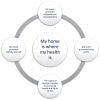My home is where my health is: narratives on health promotion from older people living at home
- PMID: 40517405
- PMCID: PMC12168385
- DOI: 10.1080/17482631.2025.2518668
My home is where my health is: narratives on health promotion from older people living at home
Abstract
Purpose: Many older people want to live at home for as long as possible, and the aging population is highlighting the importance of understanding what they require for their lives to be good. This study explored how older recipients of home care experience the meaning of home from a health-promoting perspective.
Methods: Narrative interviews were conducted with 10 people aged 78-103 years living at home and receiving home care nursing. We conducted a thematic narrative analysis, and based on the results chose a salutogenic perspective to shed light on the health-promoting perspective.
Results: The primary theme identified was "My home is where my health is." It reflects a compellation of the four subthemes emerging from the data: (1) my home promotes independence and autonomy, (2) my home promotes identity and self, (3) my home promotes being active, and (4) the support I receive is pivotal to promoting health and life at home. These themes are pivotal to health promotion and well-being in old age.
Conclusions: Living at home contributes to meaningfulness, manageability, comprehensibility, and a sense of coherence. This promotes health and well-being for older people living at home if they receive both formal and informal support.
Keywords: Older people; ageing in place; health promotion; home care nursing; home-dwelling; living at home; meaning of home; narrative; sense of coherence.
Conflict of interest statement
No potential conflict of interest was reported by the author(s).
Figures
Similar articles
-
Narratives of health-promoting experiences by older husbands and wives providing care to their home-dwelling spouses receiving home-care services in Norway.BMC Health Serv Res. 2024 Dec 18;24(1):1600. doi: 10.1186/s12913-024-12097-3. BMC Health Serv Res. 2024. PMID: 39696475 Free PMC article.
-
'I'm not just a number on a sheet, I'm a person': Domiciliary care, self and getting older.Health Soc Care Community. 2020 May;28(3):903-912. doi: 10.1111/hsc.12921. Epub 2019 Dec 12. Health Soc Care Community. 2020. PMID: 31833154 Free PMC article.
-
Balancing risk prevention and health promotion: towards a harmonizing approach in care for older people in the community.Health Care Anal. 2014 Mar;22(1):82-102. doi: 10.1007/s10728-011-0200-1. Health Care Anal. 2014. PMID: 22228192 Free PMC article.
-
Improving support and planning ahead for older people with learning disabilities and family carers: a mixed-methods study.Health Soc Care Deliv Res. 2024 Jun;12(16):1-161. doi: 10.3310/MTHW2644. Health Soc Care Deliv Res. 2024. PMID: 38940476
-
Smart Home Technologies for Enhancing Independence of Living and Reducing Care Dependence in Older Adults: A Systematic Review.J Adv Nurs. 2025 Jun;81(6):2885-2912. doi: 10.1111/jan.16569. Epub 2024 Oct 24. J Adv Nurs. 2025. PMID: 39445693
References
-
- Ahmed, S. K. (2025). Sample size for saturation in qualitative research: Debates, definitions, and strategies. Journal of Medicine Surgery and Public Health, 5, 100171. 10.1016/j.glmedi.2024.100171 - DOI
-
- Aliakbarzadeh Arani, Z., Zanjari, N., Delbari, A., Foroughan, M., & Ghaedamini Harouni, G. (2022). Place attachment and aging: A scoping review. Journal of Human Behavior in the Social Environment, 32(1), 91–17. 10.1080/10911359.2020.1860852 - DOI
-
- Antonovsky, A. (1987). Unraveling the mystery of health: How people manage stress and stay well. Jossey-Bass.
MeSH terms
LinkOut - more resources
Full Text Sources
Medical

